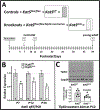Evidence that the acetyltransferase Tip60 induces the DNA damage response and cell-cycle arrest in neonatal cardiomyocytes
- PMID: 33609538
- PMCID: PMC8154663
- DOI: 10.1016/j.yjmcc.2021.02.005
Evidence that the acetyltransferase Tip60 induces the DNA damage response and cell-cycle arrest in neonatal cardiomyocytes
Abstract
Tip60, a pan-acetyltransferase encoded by the Kat5 gene, is enriched in the myocardium; however, its function in the heart is unknown. In cancer cells, Tip60 acetylates Atm (Ataxia-telangiectasia mutated), enabling its auto-phosphorylation (pAtm), which activates the DNA damage response (DDR). It was recently reported that activation of pAtm at the time of birth induces the DDR in cardiomyocytes (CMs), resulting in proliferative senescence. We therefore hypothesized that Tip60 initiates this process, and that depletion of Tip60 accordingly diminishes the DDR while extending the duration of CM cell-cycle activation. To test this hypothesis, an experimental model was used wherein a Myh6-driven Cre-recombinase transgene was activated on postnatal day 0 (P0) to recombine floxed Kat5 alleles and induce Tip60 depletion in neonatal CMs, without causing pathogenesis. Depletion of Tip60 resulted in reduced numbers of pAtm-positive CMs during the neonatal period, which correlated with reduced numbers of pH2A.X-positive CMs and decreased expression of genes encoding markers of the DDR as well as inflammation. This was accompanied by decreased expression of the cell-cycle inhibitors Meis1 and p27, activation of the cell-cycle in CMs, reduced CM size, and increased numbers of mononuclear/diploid CMs. Increased expression of fetal markers suggested that Tip60 depletion promotes a fetal-like proliferative state. Finally, infarction of Tip60-depleted hearts at P7 revealed improved cardiac function at P39 accompanied by reduced fibrosis, increased CM cell-cycle activation, and reduced apoptosis in the remote zone. These findings indicate that, among its pleiotropic functions, Tip60 induces the DDR in CMs, contributing to proliferative senescence.
Keywords: Atm; Cell-cycle; DNA damage response; Myocardial infarction; Neonatal cardiomyocytes; Tip60.
Copyright © 2021 Elsevier Ltd. All rights reserved.
Conflict of interest statement
Disclosures
No conflicts of interest, financial or otherwise, are declared by the authors.
Figures






Similar articles
-
Conditional depletion of the acetyltransferase Tip60 protects against the damaging effects of myocardial infarction.J Mol Cell Cardiol. 2022 Feb;163:9-19. doi: 10.1016/j.yjmcc.2021.09.012. Epub 2021 Oct 2. J Mol Cell Cardiol. 2022. PMID: 34610340 Free PMC article.
-
Depletion of Tip60 from In Vivo Cardiomyocytes Increases Myocyte Density, Followed by Cardiac Dysfunction, Myocyte Fallout and Lethality.PLoS One. 2016 Oct 21;11(10):e0164855. doi: 10.1371/journal.pone.0164855. eCollection 2016. PLoS One. 2016. PMID: 27768769 Free PMC article.
-
Myh6-driven Cre recombinase activates the DNA damage response and the cell cycle in the myocardium in the absence of loxP sites.Dis Model Mech. 2020 Dec 18;13(12):dmm046375. doi: 10.1242/dmm.046375. Dis Model Mech. 2020. PMID: 33106234 Free PMC article.
-
Tip60: updates.J Appl Genet. 2018 May;59(2):161-168. doi: 10.1007/s13353-018-0432-y. Epub 2018 Mar 16. J Appl Genet. 2018. PMID: 29549519 Review.
-
Post-translational modifications of epigenetic modifier TIP60: their role in cellular functions and cancer.Epigenetics Chromatin. 2025 Apr 4;18(1):18. doi: 10.1186/s13072-025-00572-y. Epigenetics Chromatin. 2025. PMID: 40186325 Free PMC article. Review.
Cited by
-
Role of Histone Modifications in Kidney Fibrosis.Medicina (Kaunas). 2024 May 28;60(6):888. doi: 10.3390/medicina60060888. Medicina (Kaunas). 2024. PMID: 38929505 Free PMC article. Review.
-
Experimental Insights into the Interplay between Histone Modifiers and p53 in Regulating Gene Expression.Int J Mol Sci. 2023 Jul 3;24(13):11032. doi: 10.3390/ijms241311032. Int J Mol Sci. 2023. PMID: 37446210 Free PMC article. Review.
-
Polyploidy Promotes Hypertranscription, Apoptosis Resistance, and Ciliogenesis in Cancer Cells and Mesenchymal Stem Cells of Various Origins: Comparative Transcriptome In Silico Study.Int J Mol Sci. 2024 Apr 10;25(8):4185. doi: 10.3390/ijms25084185. Int J Mol Sci. 2024. PMID: 38673782 Free PMC article.
-
Tert promotes cardiac regenerative repair after MI through alleviating ROS-induced DNA damage response in cardiomyocyte.Cell Death Discov. 2024 Aug 26;10(1):381. doi: 10.1038/s41420-024-02135-8. Cell Death Discov. 2024. PMID: 39187478 Free PMC article.
-
Ruvbl2 Suppresses Cardiomyocyte Proliferation During Zebrafish Heart Development and Regeneration.Front Cell Dev Biol. 2022 Feb 1;10:800594. doi: 10.3389/fcell.2022.800594. eCollection 2022. Front Cell Dev Biol. 2022. PMID: 35178388 Free PMC article.
References
Publication types
MeSH terms
Substances
Grants and funding
LinkOut - more resources
Full Text Sources
Other Literature Sources
Research Materials
Miscellaneous

